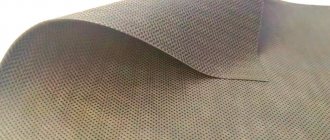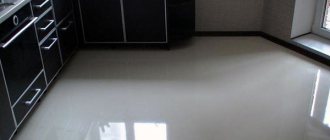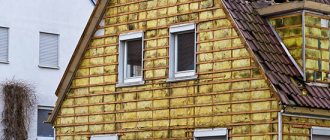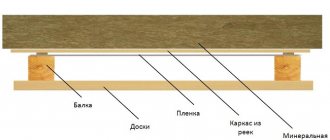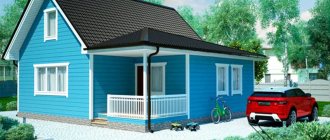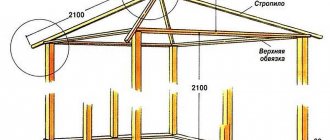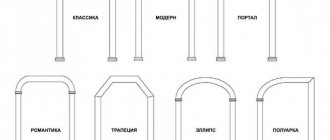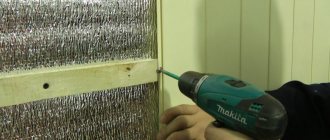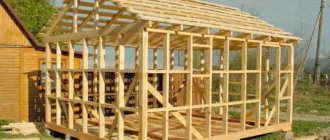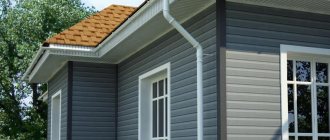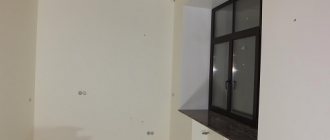Types of Isospan
Let's start with what Izospan is. This is the trademark under which the Tver company Hexa produces non-woven building materials - films and membranes for various purposes. In short, there are vapor barrier, windproof and waterproofing roll materials. There are a lot of materials, so the names, applications and features are summarized in a table. It's easier to navigate this way.
Instructions for use of Izospan depend on the area of its application
| Name | Purpose | Application area | Structural features | Properties |
| Izospan AQ proff | Vapor-permeable hydro-wind protection | Sloping roof (insulated and non-insulated), frame walls, wall insulation, ventilated facade, attic and interfloor ceilings | Three-layer reinforced membrane | Protects from wind, allows steam to pass through, but retains moisture |
| Izospan AQ 150 proff | Vapor-permeable hydro-wind protection | Sloping insulated roof, frame walls, wall insulation, ventilated facade, attic and interfloor ceilings | Three-layer membrane | -//- |
| Izospan AS 130 | Vapor-permeable hydro-wind protection | Sloping insulated roof, frame walls, wall insulation, ventilated facade, attic and interfloor ceilings | Membrane | -//- |
| Izospan AS | Vapor-permeable hydro-wind protection | Sloping insulated roof, frame walls, wall insulation, ventilated facade, attic and interfloor ceilings | Three-layer membrane | -//- |
| Izospan AM | Vapor-permeable hydro-wind protection | Sloping insulated roof, frame walls, wall insulation, ventilated facade, attic and interfloor ceilings, internal walls | Three-layer membrane | -//- |
| Izospan A base | Windproof membrane with vapor permeability | Basement over ventilated subfloor | Windproof membrane | Protects from wind, allows steam and moisture to escape |
| Izospan A with OZD | Vapor-permeable hydro-wind protection with increased fire resistance | Ventilated facades | Membrane with fireproof impregnation | Protects from wind, allows steam to pass through, but retains moisture and reduces the risk of fire |
| Izospan AF+ | Non-flammable wind protection and waterproofing does not prevent the release of vapors | Ventilated facades | Non-flammable membrane | Reduces blowing heat, releases steam, protects against moisture, does not burn or support combustion |
| Izospan B | Vapor barrier, waterproofing | Sloping insulated roofing, frame walls, wall insulation, attic, basement and interfloor ceilings | Two-layer material (smooth on one side, rough on the other) | Does not allow steam, moisture, or insulation particles to pass through |
| Izospan RS | Vapor barrier, waterproofing | Sloping insulated and flat roofing, frame and internal walls, attic, basement and interfloor ceilings, floors on concrete bases | Three-layer reinforced material | Does not conduct moisture in liquid or vapor state |
| Izospan B fix | Vapor barrier, waterproofing | Sloping insulated roofing, frame walls, wall insulation, attic, basement and interfloor ceilings | Izospan B with two adhesive strips for easier fixation of panels | Does not allow steam, moisture, or insulation particles to pass through |
| Izospan C | Vapor barrier, waterproofing | Sloping insulated roofing, frame and internal walls, attic, basement and interfloor ceilings, floors on concrete bases | Two-layer material (smooth on one side, rough on the other) | Does not allow steam, moisture, or insulation particles to pass through |
| Izospan RM | Reinforced vapor-hydro-insulation | Flat roofs, floors on concrete bases | Three-layer material with an additional reinforcing layer | Does not allow steam or liquid moisture to pass through |
| Izospan D | High-strength vapor-waterproofing | Flat roofs, non-insulated sloping roofs, floors on concrete bases | Two-layer material based on woven polypropylene fabric | High resistance to steam and moisture, increased mechanical strength |
| Izospan D fix | High-strength vapor-waterproofing | Flat roofs, non-insulated sloping roofs, floors on concrete bases | Izospan D with two adhesive strips for easier fixation of panels | High resistance to steam and moisture, increased mechanical strength |
| Izospan DM | High-strength vapor-waterproofing with anti-condensation surface | Sloping insulated and non-insulated roofs, all types of floors, frame walls | Izospan D with anti-condensation properties | High resistance to steam and moisture, increased mechanical strength, no condensation |
| Izospan RF | Reflective vapor barrier, high strength waterproofing | Insulated pitched roofs, all types of floors, frame walls, heated floors | Multilayer material based on non-woven fabric with a reflective (shiny) layer | Reflects thermal radiation, retains moisture in any condition |
| Izospan FD | Reflective vapor barrier, high strength waterproofing | Insulated pitched roofs, all types of floors, frame walls, heated floors | Multilayer material based on woven fabric with a reflective (shiny) layer | Reflects thermal radiation, retains moisture in any condition |
| Izospan FS | Reflective vapor barrier, waterproofing | Insulated pitched roofs, all types of floors, frame walls, heated floors | Non-woven fabric+metalized film | Reflects thermal radiation, retains moisture in any condition |
| Izospan FB | Reflective vapor barrier, waterproofing for saunas and baths | Saunas and baths | Kraft paper with metallized surface | Reflects thermal radiation, retains moisture in any condition, tolerates high temperatures |
| Izospan FX | Reflective vapor barrier, waterproofing | Insulated pitched roofs, all types of floors, frame walls, heated floors, parquet and laminate flooring | Foamed polyethylene + metallized layer | Reflects thermal radiation, retains moisture in any condition, has thermal insulating properties |
| Izospan KL | Double-sided adhesive tape | Sealing vapor barrier connections | Adhesive layer - acrylic | Width 15 mm, tape length per roll 50 m |
| Izospan KL+ | Double-sided adhesive tape | Sealing of material joints, fastening them to building materials (concrete, plastic, wood, metal) | Adhesive layer - acrylate | Width 25 mm, length 25 m |
| Izospan SL | Double Sided Joint Tape | Sealing joints of materials, fastening them to rough surfaces (stone, brick) | Butyl rubber tape | Width 15 mm, tape length per roll 25 m |
| Izospan SL proff | Double-sided high-adhesion bonding tape | For reliable fastening and sealing of junctions with other materials | Butyl rubber tape | Width 15 mm, tape length per roll 22 m |
| Izospan FL | Metallized Joint Tape | To connect the vapor barrier to the reflective layer | Polypropylene with metallized layer | Width 50 mm, length 50 m |
| Izospan FL Termo | Metallized connection tape with increased heat resistance | For connecting vapor barrier with a reflective layer in baths and saunas | Aluminum tape with adhesive layer | Width 50 mm, length 40 m |
| Izospan ML proff | High Strength Single Sided Adhesive Tape | For gluing materials to building materials | Acrylate | Width 50 mm, length 50 m |
| Self Adhesive Sealing Tape (SAL) | Foamed polyethylene with adhesive layer | Protection against leakage at the junctions of materials with rafters on roofs | Foamed polyethylene | Width 50 mm, length 30 m |
As you can see, all Izospan materials can be divided into three groups:
- Wind protection. This is a group of Izospan A materials and varieties. These are materials that protect the insulation from blowing, retaining heat. At the same time, they remain permeable to steam, but do not conduct/permeate moisture.
- Steam-waterproofing materials. These are Izospan B, C, R and several of their varieties. They do not allow moisture to pass through in any form.
- Energy-saving vapor-waterproofing Izospan F. It is distinguished by the presence of a metallized layer; it does not allow moisture to pass through in any form - neither steam nor liquid.
There are also connecting materials - single- and double-sided connecting tapes on different bases. They are needed during installation and allow you to avoid deterioration of performance at joints. Some allow you to achieve tight connections.
How to distinguish by name
The name of the materials contains a key letter, by which the group and main properties can be determined. So Izospan A with all other indices means a vapor-permeable membrane. Izospan V, D, C - hydro-vapor barrier. The difference between the films of this group and the first is that these materials (B, C, D) do not allow steam to pass through. The materials of the first group (A) conduct it (steam) and retain only water. The exception is Izospan A base. It does not retain water and conducts steam.
Instructions for use depend on the type of material
The third group is also hydro-vapor barrier. It differs in that it has a metallized coating. The names of materials in this group contain the letter F: FD, FX, FS, FB, RF. They are used to more effectively retain heat, since heat rays are reflected from the shiny coating. But reflection is only possible if there is an air gap in front of the film of 3.5 cm (or more).
After the first letter in the Izospan marking there is often a second one. It describes the special properties of a material. It can also be an abbreviation or short word. For example, the presence of the letter M or S indicates the presence of reinforcement. The fix prefix means that strips of glue are applied along the edges, so there is no need to use tape.
Methods of using the membrane
Izospan is a synthetic film based on polypropylene. It absolutely does not absorb water and prevents moisture from entering the main layer of insulation, be it polystyrene foam or a material based on mineral or basalt wool. The ideal moisture and vapor barrier of isospan was appreciated by everyone involved in construction, as well as other advantages of the material:
- It prevents the penetration of air into the interior of the room through natural cracks and pores of the main building material, thus providing protection from drafts and cooling of the room.
- Protection of metal from rust formation.
- Protecting wood from rotting.
- Protection of the main insulation from moisture penetration and condensation formation, which significantly reduce the performance of the insulation.
On a note.
Izospan is an absolutely environmentally friendly material that does not release harmful impurities into the surrounding air. It can be used in the construction of residential premises or insulation of children's areas.
Izospan A: instructions for use
Group of materials Izospan A - vapor-conducting windproof membranes that do not conduct liquid water. The exception is Izospan A base. This membrane is only wind protection. It does not interfere with the passage of steam and water. Used in the ceiling above a ventilated facade, stuffed from the underground side. Protects mineral wool from blowing and does not interfere with the removal of moisture from the insulation.
| Name | Maximum elongation in transverse/longitudinal direction N/50 mm | Withstands steam density, g/m2*24 h | Withstands water pressure, mm.water.st. | Withstands ultraviolet radiation (without protective coatings) for at least months |
| Izospan AQ proff | 330/220 | 1000 | 1200 | 12 |
| Izospan AQ 150 proff | 270/160 | 880 | 1200 | 12 |
| Izospan AS 130 | 240/130 | 880 | 1200 | 3-4 |
| Izospan AS | 190/110 | 880 | 1200 | 3-4 |
| Izospan AM | 160/100 | 880 | 1200 | 3-4 |
| Izospan A | 190/140 | 2000 | 300 | 3-4 |
| Izospan A base | 170/100 | 1700 | — | 3-4 |
| Izospan AF+ (NG) | 1400/1000 | 800 | 900 | — |
| Izospan A with OZD (RP-1) | 190/140 | 1800 | 300 | 3-4 |
To understand where and how best to use Izospan A, look at the characteristics. Once again: the film is not blown (retains heat), removes steam, and does not allow water to pass through. These properties are needed in the following constructions.
Rules for laying and installing windproof, vapor-permeable membranes
Vapor barrier materials are laid on vertical, inclined and horizontal surfaces. Despite the fact that the designs are different, the installation rules are no different. Here's what to remember:
The basic rule of installation is to make overlaps and carefully glue them
- On pitched roofs and walls, work begins from below. On horizontal roofs - from one of the walls.
- The second layer of material is laid overlapping. That is, one panel overlaps another by no less than:
- 10 cm on walls;
- 15 cm on roofs;
- 15-20 cm in overlaps.
- Vertical joints (if any) have the same dimensions.
- All connections of the canvases are glued using double-sided adhesive tapes.
- The connection to the walls and rafter system is also glued. To adjoin the rafter system, it is recommended to use self-adhesive sealing tape Izospan. For joints - KL, for adjoining the structure KL+.
The task of vapor-permeable waterproofing and windproofing is to allow steam to pass through, but not to allow moisture to enter in a liquid state. Therefore, the strength of the joints is important.
On a pitched roof, on top of insulation
The vapor barrier is laid on top of mineral wool and covered with any roofing material. Let's see how everything works. Here it is necessary that the steam that gets into the insulation from the attic is removed. At the same time, condensation and possible leaks did not enter the insulation. So you need to remove steam and not let water through. This is what Izospan A does.
Application of Izospan A in an insulated pitched roof
The membranes are turned with the logo facing towards you. It is better to lay it not under tension, but with sagging. In this case, condensation, which cannot be avoided on the roof, will flow into the center, and then into the gutter of the drainage system. This way it will dry out faster even in damp times, moisture will be retained less, and there is less chance of it getting into the insulation.
On top of the vapor barrier, slats are placed along the rafters, and then across the sheathing for installation of the roofing material. With this device and the presence of ventilation holes in the roof, the vapor barrier will be blown and dried.
In frame walls on the street side
Typically, indoor humidity is higher than outdoors. And no matter how much we protect the walls, steam leaks into them. These are the laws of physics. And since he hit the wall, he needs to be taken out. So the task here is the same - to let off steam. This can only be done from the street side. So Izospan A in frame walls is also placed on the street side. Here you can use all types of Izospan A, except for the “base”.
Izospan A - instructions for use in a frame wall
When using Izospan A “in its pure form”, it does not matter which side it is laid on. We unfold all other modifications - AS, AQ, AM - so that the logo is facing out.
When insulating walls with mineral wool and for ventilated facades
With external insulation of walls, in ventilated facades, the situation is almost the same as with the frame. Some moisture is seeping into the wall from the room. Then it penetrates into the insulation. Since wet mineral wool is a poor insulator, care must be taken to ensure that this steam is quickly removed. At the same time, it is necessary to protect the cotton wool from getting wet and retain heat as much as possible. That is, the problem is solved by the same vapor-permeable membranes of the Izospan A group.
Application of Izospan A for external wall insulation and in the system of ventilated facades
Any vapor barrier for use in the case of external wall insulation, except Izospan A with OZD, AF+ and base. The installation rule is the same - turn it with the logo facing you. For use in ventilated facade systems, Izospan AF+ is recommended. If a metal structure is used, its strength will ensure that the vapor barrier will not break. If the ventilated facade is covered with wooden blocks, Izospan AM, AS and AQ in any of the options may well be suitable.
Ceiling over a ventilated subfloor
The floor insulated with mineral wool over a ventilated base has its own characteristics. First and most important, for the scheme to work, the subfloor must be ventilated. This means that there must be vents in the foundation. And they must be open even in winter, otherwise you will have wet insulation and cold in the house.
How does this pie work? From the side of the house, moisture and steam seep into the insulation. If you simply line the insulation with mesh or slats, the wind blowing underground will do an excellent job of removing moisture. But at the same time, it will carry away heat and gradually remove mineral wool particles, reducing its thickness. To get rid of heat and insulation from escaping, Izospan A base vapor barrier is used. It allows steam and moisture to pass freely in both directions, but does not allow wind to pass through.
Izospan A: instructions for use in the ceiling above a ventilated subfloor
The following objection may arise. Moisture from the soil will evaporate and enter the insulation. Under certain conditions, it condenses on the membrane, causing the insulation to become wet. Maybe it’s better to use a vapor barrier with waterproofing properties? No. This won't work. If the membrane does not conduct moisture, then the moisture that condenses or gets into the insulation will remain there. Because it will not heat up enough to evaporate and be released as steam. In a couple of years you will have bags of water hanging from the ceiling and completely wet and unusable insulation.
And in order to reduce the evaporation of moisture from the soil, a dense film is placed in the underground, a layer of sand (any kind, but without clay and dust) is poured on it in a layer of 5-10 cm. The film retains most of the moisture, and the sand works as an adsorbent, absorbing fallen condensate. It (the sand) is also dried by the passing wind.
Interfloor and attic floors
In ceilings, steam enters from below and must be discharged from above. Therefore, a vapor barrier is placed at the bottom to protect against moisture, and a vapor-permeable wind barrier is placed at the top. In this case, it also additionally protects against the penetration of mineral wool particles into the room. You need to put Izospan in the same way - the logo should be facing you.
Izospan A for flooring - in interfloor and attic floors
In the interfloor ceiling, to reduce the cost, vapor-permeable Izospan can be replaced with non-woven material (any type of geotextile). Its main function here is to protect against the penetration of small mineral wool particles into the air. But you can do this only if the flooring is sheet material in two layers, with the seams spaced apart. Otherwise, moisture may seep in and then simply the non-woven material will not protect the insulation from getting wet.
In the attic floor, such a replacement is not considered at all - here it is also necessary to protect the heat from weathering. So wind protection is necessary here.
Also note that the vapor barrier is attached to the beams with counterbattens. And the flooring is already laid on them. Counter rails are needed to create a ventilation gap, which is a prerequisite for moisture evaporation. It is important.
Vapor-permeable membranes for waterproofing and wind protection
A membrane made of non-woven fabric for creating waterproofing, vapor-permeable barriers is developed for external work on thermal insulation of roofs and wall structures. The material does not allow moisture to pass through and is able to protect the insulation from the effects of precipitation and wind.
In addition to waterproofing the insulation, the diffusion membrane performs another function - it prevents condensation of moisture entering the fibrous heat insulator through the walls of the building along with steam. The steam is quickly released outside, so that wooden structures are not threatened by fungus, and the insulation does not lose its thermal insulation properties.
Example of ceiling vapor barrier
Diffusion membranes are made of polypropylene. Their use is safe for human health and prevents the appearance of fungus. Scope of use
:
- insulation of pitched roofs with an angle of inclination over 35°;
- construction of frame houses;
- external wall cladding with siding or clapboard;
- hydro- and wind protection of heat insulation under ventilated facades.
Izospan A, AM, AS, AQ proff, A with OZD
The line of hydro-windproof, vapor-permeable membranes includes non-woven materials of various densities
:
- Izospan A (density indicator 110 g/m2) is the most permeable membrane of the entire line, it allows moisture to escape out, but does not let it in. When installing, it is necessary to leave a gap for ventilation.
- Izospan AM (90 g/m2) is a three-layer membrane. The technical characteristics of Izospan AM allow the installation of a protective hydro- and wind barrier without a ventilation gap, since air circulates between the layers of material and removes moisture.
- Izospan AS (115 g/m2) is also a three-layer diffusion non-woven material, but more dense than AM.
- Izospan AQ proff (120 g/m2) is a professional material. Izospan AQ proff has a three-layer structure with reinforced reinforcement. It is recommended to use Izospan AQ proff if externally insulated walls or roofing systems will have to be left for some time without an external protective and decorative coating. Features of Izospan AQ proff - increased resistance to moisture, ultraviolet radiation, and mechanical damage.
- Izospan A with OZD - the material differs from Izospan A in the presence of fire retardant additives. A non-flammable membrane is used if welding work is expected to be carried out in close proximity to an insulated structure, for example, when installing ventilation facades.
Be sure to read: Which side to lay the vapor barrier to the insulation
Table of vapor-permeable membranes
Microporous membranes are made of two or three layers. Their characteristic feature is the different quality of the material on the front and back sides. One side is smooth, the other is rough. Hydro-windproof Izospan is laid to the insulation with the white side, if we are talking about Izospan AQ proff, AM and AS membranes
.
In this case, the diffusion barrier Izospan A and A with OZD, according to the instructions, is mounted with the smooth side out
. The accumulated condensate should flow along it into the drainage drain.
Instructions for using vapor barrier Izospan V, C, D
Izospan vapor barrier films are also waterproofing. They do not allow water or steam to pass through. What are the differences between Izospan A and B? The fact is that B does not let steam through, A does. That's it in short.
Made from different materials. There are films, nonwovens and fabrics made of polyethylene and polypropylene. Fabric-based materials have very high strength characteristics. Their use is justified in places where they may be subject to high mechanical loads. Technical characteristics of Izospan vapor barrier films are given in the table.
| Name | Maximum elongation in transverse/longitudinal direction N/50 mm | Vapor permeability | Withstands water pressure, mm.water.st. | Withstands ultraviolet radiation (without protective coatings) for at least months |
| Izospan RS (рс) | 413/168 | No | 1200 | 3-4 |
| Izospan B and B fix | 130/107 | No | 1200 | 3-4 |
| Izospan S | 197/119 | No | 1200 | 3-4 |
| Izospan RM (rm) | 399/172 | No | 1200 | 3-4 |
| Izospan D (D) and D fix | 1068/890 | No | 1200 | 3-4 |
| Izospan DM (DM) | 700/650 | No | 300 | 3-4 |
The main task of these materials is to cut off steam from the insulation as efficiently as possible and at the same time provide protection from moisture. A “side” but important effect is protection against the penetration of mineral wool particles into the indoor air. It is used in the construction of walls, ceilings, roofs, and when constructing concrete floors. Vapor barriers are often part of the “pies” above, simply because they perform other tasks.
Rules for installing vapor barriers
The main task when laying vapor barrier films is to achieve as complete a seal as possible. It is necessary to let as little steam as possible into the insulation. We make all connections reliable using sealing and connecting tapes. The basic rules of vapor barrier do not differ from those described above:
- On the walls and roof we start from the bottom.
- The next canvas overlaps the first by 10-20 cm.
- We make vertical joints with an overlap of at least 20 cm.
Vapor barrier materials are usually installed from the inside of the room
- We glue all connections with double-sided tape.
- We make connections to building materials using mounting and connecting tapes.
- When used for flat roofs and ceilings, the vapor barrier is applied to the walls and sealed there.
In addition to gluing the joints of the canvases, it is also important to use even strips-bars for final fastening of the material. They press the material tightly, sealing at the same time the holes that the fasteners invariably pierce.
Pitched roofs - insulated and non-insulated
Pitched roofs can be insulated or cold. In any case, a vapor barrier is installed on the attic side. It does not let steam into the insulation and this is its main task for this case. But Izospan is recommended differently for insulated and non-insulated roofs:
- for insulated roofing it is better to use RS, B or B fix, they differ in strength (RS is stronger);
- for non-insulated - D or D fix, DM (DM is stronger than just D).
Application of Izospan vapor barrier for roofing
Izospan RS and B films have one rough side and the other smooth. So, Izospan V and RS should be turned with the rough side into the room. We unfold the smooth one towards the insulation or roofing material.
Flat insulated roofs
When insulating a flat roof, a vapor barrier is laid on the ceiling under the insulation. The purpose of this layer is twofold. On the one hand, do not let steam into the insulation, on the other, cut off moisture from the ceiling in the event of a leak.
How to use Izospan when insulating a flat roof
In this case, it is recommended to use Izospan D and RM, RS. They have sufficient strength to withstand the loads that will certainly arise when laying insulation.
Izospan B: instructions for use for walls
In frame walls, Izospan V vapor barrier is installed on the side of the room. The task of vapor barrier is to let as little steam into the insulation as possible. Whatever gets into it (and it will definitely get in) will come out, since there is a vapor-permeable Izospan A film on the outside. But the less moisture there is, the better.
Izospan A and B - instructions for use for frame walls
In this case, Izospan RS (RS) and B are recommended for use. The strength of RS will be required only if you are planning a break in work and the cladding will be mounted on the walls after some time. The smooth side of Izospan B goes to the insulation, the rough side is directed into the room. This is the basic rule.
Please note that in the diagram Izospan B is nailed to the racks with strips, and sheet wall covering material is mounted on the sheathing strips. This option is good because it allows you to use a strip to isolate the holes made by the fasteners. There is another option - you can attach the film to the stands using a stapler and staples with wide backs. The inconvenience is that the rack will not be visible and it is unclear where to attach the sheet material. But the option is possible, although not ideal.
Attic and interfloor ceilings
A vapor barrier in a wooden floor pie is needed from the lower room. If you look from bottom to top, the sequence goes like this:
- ceiling filing;
- vapor barrier (Izospan V);
- rough ceiling;
- insulation between beams;
- vapor-permeable film (Izospan A);
- floor laid on a counter-batten.
Which Izospan to lay on the ceiling side in the attic and interfloor ceilings
How does the vapor barrier work in this cake? It does not allow vaporous moisture to pass from the room into the insulation. If there is a leak from above, it will also retain moisture, but this is an emergency and the water will not hold for long.
Which side should Izospan B be placed in this case? The rough side goes into the room, the smooth side goes up. When installing, try to damage the panel as little as possible. If a hole has formed somewhere, seal it with tape. Branded is better, but you can also just use a good one, with a high-quality sticky layer.
Basement ceiling
The basement floor is built according to a completely different logic. Here steam will flow from top to bottom. From a warm room with humid air to a cooler and drier underground. And so that moisture penetrates into the insulation as little as possible, we put a vapor barrier on it (the thermal insulation). The steam that gets into the insulation will either fall on the ground in the form of drops, or will be carried away by the wind in a vaporous state.
Vapor barrier Izospan B and RS in the basement
Izospan B and RS are recommended for use. When laying, we turn the rough side towards the insulation, the smooth side faces the room. The films are laid on beams and secured with slats - counter-battens. The flooring is already being laid on them.
For better heat conservation, you can use vapor barrier materials with a metallized layer: RF, FS, FD, FX. In this case, the thickness of the counter rails is at least 35 mm. This is the minimum gap that ensures effective heat reflection.
Screed on concrete base
If it is necessary to level a concrete slab, a screed is often used. To prevent water from the solution from leaking into the ceiling, it is advisable to use waterproofing. This can be a coating or rolled material. The cheapest is film. But you will have to walk on it and it is unlikely to remain intact. Especially if the screed is reinforced. Is it possible to pour screed without film? If you are not afraid of flooding your neighbors below, then you can. Or if you use coating waterproofing. Without it, most likely, the screed will not have the required strength. A certain amount of moisture is required for the formation of cement stone. And it will partially go into the slab, and partially seep through the cracks. What the result will be is unknown. Accordingly, it is advisable to use film.
Application of waterproofing in floors on a concrete base
It is recommended to install Izospan D (D) or Izospan RM (RM) vapor barrier under the screed on a concrete base. These are waterproofing materials of increased strength. It doesn’t matter which side these materials are laid on. But Izospan D has very high strength and it makes sense to use it only if reinforcement will be laid. For a screed without reinforcement, RM is quite sufficient.
If there are significant depressions in the base, it is better to seal them; it makes sense to cut off humps that are too protruding. This will not only increase the chances of preserving the film, but will also make the screed thinner. And this is a significant saving.
Wind-waterproofing options
Izospan B
Izospan b was developed specifically to combat condensation, which is necessarily contained in the air coming from the house. The structure of this material differs from isospan - its upper surface is smooth, its inner surface is fleecy. The fleecy surface has maximum absorbency - it collects condensation and then gradually evaporates it back. Water vapor does not reach the main insulation and does not reduce its technical characteristics.
We look and install isospan B according to all the rules.
During installation, the smooth side of isospan B is adjacent to the insulation, while the fleecy side faces the inside of the room. Please note that during subsequent installation of drywall or any other material there must be a gap between the isospan. Lay isospan correctly with an overlap of 50-100 mm.
Izospan S
Izospan C is completely identical in structure to Izospan B. The same smooth inner side and fleecy outer side to retain condensation. The main difference is significantly higher strength characteristics. This material costs about half as much to purchase.
Izospan C is less often used when constructing roofs, with the exception of flat roofing; it is mainly used to insulate load-bearing external walls and interfloor ceilings. The overlap when working with this type of isospan should be at least 150 mm. The joints are glued together with a special adhesive tape similar to double-sided tape. Izospan tape is sold separately.
The vapor barrier of the floor is perfectly carried out using isospan C, which is spread directly on the base, taking into account the overlap, and a concrete screed is placed on top of it. Please note that gluing the waterproofing joints is mandatory. The flooring is installed after the concrete screed has completely dried.
Izospan D
Izospan D belongs to the class of fully waterproofing materials. The structure is a dense film of solid polypropylene with one-sided lamination. It is particularly durable, in particular, able to withstand strong gusts of wind and heavy snow loads.
Example of isospan D for installation.
This type of isospan is used everywhere: when installing roofs, for insulation and vapor barrier of external walls, ceiling slabs, for waterproofing foundations, it is actively used to protect metal structures of garages, and in the construction of cellars.
I would especially like to note that isospan d is used as a temporary roof or temporary walls on objects under construction. This type of film can withstand up to 4 months of adverse weather conditions as a temporary roof. In this case, the isospan is rolled out directly onto the rafters and secured with slats. The waterproofing of Izospan D makes it indispensable for insulating basements, basements, installing concrete floors, and arranging garages and cellars.
On a note.
The isospan D film is homogeneous on both sides, there is no need to determine which side to spread the material on. It is laid directly on the rafters on top of the insulated roof surface.
Izospan with reinforced mesh RS/RM
The vapor barrier membrane Izospan RS/RM is used to protect residential and non-residential premises from moisture. A special feature of the material is a reinforced mesh sealed in polypropylene. Thus, the membrane acquires additional rigidity and strength.
Izospan RS/RM is optimally suited for the construction of houses using frame technology, for protecting wooden elements. It is also successfully used for waterproofing basement floors, increasing the service life of the entire structure as a whole.
Vapor barrier with reflective layer Izospan F
The third group of materials is vapor barrier films with the effect of heat reflection. They differ in that the outer layer is a metallized film (lavsan or polypropylene). They can be used instead of similar materials (vapor barriers) in all of the above structures. If there is an air gap, the material is able to reflect thermal radiation back into the room.
| Name | Type of metallized film | Maximum elongation in transverse/longitudinal direction N/50 mm | Vapor permeability | Withstands water pressure, mm.water.st. | Withstands ultraviolet radiation (without protective coatings) for at least months |
| Izospan RF | polypropylene | 450/300 | No | 1200 | 3-4 |
| Izospan FD | polypropylene | 800/700 | No | 1200 | 3-4 |
| Izospan FS | polypropylene | 300/330 | No | 1200 | 3-4 |
| Izospan FB | lavsan | 350/340 | No | 1200 | 3-4 |
| Izospan FX | lavsan | 176/207 | No | 1200 | 3-4 |
Energy-efficient vapor barrier Izospan F is installed on the side of the room. When installing, turn the shiny side toward the room. The use of this group of materials can reduce heating costs by about 10%, but there is still debate about this: not everyone believes in it.
Metallized vapor barrier Izospan
The second area of application for Izospan F is the underlay for finishing floor coverings. Under laminate, parquet boards, and film heated floors, it is recommended to use Izospan FX. This is foamed polyethylene 2-5 mm thick with a metallized film glued. In addition to reflecting heat, it also acts as thermal insulation. Any other material of this group can be placed under all other coatings.
Using Izospan F in a heated floor system
When laying a heated floor system in a screed, the cake remains the same. Only a pipe or cable is added. But they need to be laid according to a certain pattern, so a metal mesh is also needed. Water heated floor pipes or an electric heating cable are tied to it.
Which Izospan to use under heated floors
In order not to heat the ceiling of the neighbors below, it is advisable to direct the heat as high as possible. To solve this problem, insulation is laid on the slab, and waterproofing with a heat-reflecting effect is placed on it. In this case, the material does not allow water to enter the slab and reduces heat loss during operation. For heated floors, it is recommended to use Izospan RF, FX, FD, FS.
Technical characteristics of Izospan
Let's consider the classification of isospan vapor barrier based on its characteristics and scope of application. The material is marked with the letters A, B, C, D, F, R. Additionally, letter indices can be assigned, which reveal the features of application and installation.
Isopan insulation with characteristics.
In particular, Izospan AM film, as one of the most popular, is the next generation of material. It has three layers that simultaneously provide wind, moisture and vapor protection.
Izospan: characteristics of the entire line of materials.
- Does not lose its properties at temperatures from -60 to +80 degrees Celsius.
- High elasticity allows you to wrap it around the most intricately shaped surface.
- Reflects ultraviolet light.
- Waterproof.
- Vaporproof.
- Windproof.
- Reflects heat back into the home.
- Durable - service life is about 50 years.
- Safe: does not emit harmful substances.
- Has a high fire safety class.
Advantages and disadvantages of "Izospan"
“Izospan” is rightfully one of the most popular hydro- and vapor barrier materials among builders. Naturally, there are many other brands on sale that are intended for the same purposes. However, many masters consciously make a choice in favor of Izospan.
The advantages of this material include the following:
- Membrane strength. During installation, Izospan does not tear and withstands various impacts during operation.
- Reliability. The material will well protect insulation and wooden structures from moisture penetration.
- Versatility. Izospan performs several functions and can be used to protect various structures.
- Ecological cleanliness. The material does not contain toxic substances, and therefore does not release them into the environment.
- Practicality and long service life.
- The material is simple and easy to install.
- Due to the peculiarities of its surface, the membrane ventilates the condensate that forms well, keeping the insulation and wood dry, providing them with proper protection.
- The very affordable cost of the material with its excellent characteristics is also attractive.
The shortcomings are difficult to remember, and even then, these are rather not the negative qualities of the material itself, but only the peculiarities of its use in some cases.
- Before installing Izospan, all wooden parts of the structure must be treated with an antiseptic composition. This leads to considerable additional costs and lengthens construction time, since you will have to not only process it, but also wait for the wood to dry. But it’s the same with any other materials.
- If the technology for installing hydro- and/or vapor barriers is violated, condensation may accumulate at the joints.
- “Izospan” is not recommended to be installed if weather conditions are such that there is increased air humidity.
- If waterproofing is laid on a concrete basement floor, then Izospan is not recommended to be laid on a cold base. It is recommended to heat the surface using, for example, a heat gun.
As you can see, there is not a single “sin” that could be considered a specifically “Isospan” disadvantage. Everything that has been said is inherent to other membranes to the same extent.
Which Izospan is better for roofing
Of course, the choice of the most suitable type of underlay film directly depends on the design of the roofing pie and the method of using the roof. In the simplest case, to isolate the roof from condensation and water penetrating through cracks in places where individual sheets overlap, for example, slate or metal tiles, it is possible to use Izospan A. It is somewhat inferior in tensile strength and water resistance to other brands, but in terms of price and installation looks much more attractive.
Advice! You can simplify the task of choosing isospan waterproofing film for the roof if you use a table comparing the characteristics of different brands.
Why is wall vapor barrier necessary?
In the winter season, the temperature difference in a residential building and outside reaches large values. Because of this, the warm air in the room, cooling, condenses on the walls of the building. If the walls are insulated, condensation accumulates on the heat insulator. As a result, the materials used get wet and their original thermal insulation properties are reduced. To prevent such cases, Izospan vapor barrier is used.
Preparing the surface for installation
- Before installing the Izospan film, it is necessary to inspect the insulation for gaps between the blocks, and if found, eliminate the deficiencies
- Seal the contact points between the insulation and structural elements, for example windows.
Laying isospan on walls
Izospan A is used for vapor barrier of walls both on the outside and Izospan B is well suited for the inside.
From the inside
Installation of Izospan from the inside
Installing isospan on walls from the inside is not particularly difficult:
- Insulation boards are laid in the gaps between the supporting beams.
- Izospan B is fixed on top of them using a stapler.
- Installation is carried out with an overlap, the joints are sealed.
- A counter-lattice is mounted on top of the vapor barrier.
- At the end, the finishing of the room is carried out.
Installation of Izospan begins from the bottom row with horizontal stripes. The overlap of the fabric must be at least 10 cm. The material is placed with the smooth side facing the insulation. The junction of the film to the sheathing or other surface must be taped with mounting tape.
From the outside
Installation of Izospan on the outside of the wall
When insulating from the outside of the wall, proceed in the reverse order:
- On top of the laid insulation, Izospan A is attached to the beam using a stapler.
- Installation is carried out from the bottom up with the smooth side facing out.
- Next you need to install the counter-lattice.
- The outer sheathing is attached over the counter-lattice.
This method is suitable for covering timber or boards. For log walls, a vapor barrier film can be attached without installing sheathing.
Izospan B provides double-sided protection, one side is smooth and the other is rough. It is very important to place the material with the correct side to the insulation. In any case, before installation, you should read the instructions for the correct placement of the material relative to the heat-insulating layer, otherwise an erroneous location will lead to consequences opposite to those desired.
What is isospan
This material is a diffuser-membrane film, the production of which is based on the polymerization of polyethylene.
Existing technologies make it possible to produce material with different technological characteristics. At the same time, the format, packaging and surface features allow you to lay isospan on the ceiling with maximum efficiency and quality. This material is especially in demand for work in rooms with high humidity, as well as buildings that are insulated with soft materials - mineral wool, penofol or expanded polystyrene, with joints sealed with polyurethane foam. Among the main functions that this vapor barrier material will perform are:
- protection of ceilings from the occurrence of fungus and various bacteriological formations;
- insulating the insulation and protecting it from getting wet;
- Containment of condensation and the possibility of evaporation naturally.
In addition to the above properties, isospan is worth laying because of its high strength and elasticity, which significantly facilitates work processes. This vapor barrier is environmentally friendly and can be used in rooms with any air temperature.
Varieties of Izospan for roofing
Of the fairly large number of types and varieties of under-roofing panels and films, in arranging the roof of a private house, in outbuildings, in general in any room where there are sources of water vapor and heat, the following brands are considered the most popular and frequently used:
- Universal material – Izospan “B”, is used to protect roof insulation from the penetration and condensation of water vapor, allowing the unhindered release of water vapor into the ventilated channels of the under-roof space;
- A reinforced version is Izospan “S”, the functions and tasks are the same, but it has higher strength, durability, and partially blocks the formation of a condensing thin film of water on the surface when micropores “flood”;
- Special Izospan brand “D” is used for roofing without an insulating sublayer. The functions mostly include wind protection and waterproofing of roof structures;
- The most popular and affordable option is Izospan category “A”. Its purpose is waterproofing and wind protection.
For your information!
In this case, the classification and division of the protective fabric is carried out on the basis of the technical conditions and characteristics of the Izospan trademark, produced in Russia. In addition to Izospan from Hexa, there are a huge number of similar materials on the market. Its products undergo regular testing, periodic laboratory tests and constant production quality control. Judging by the number of various awards and recognitions in the top lists of roofing materials, the quality of Izospan, produced under the control of Hexa - Nonwoven Materials, remains at the proper level. Although in the foreign classification the presence of diplomas and certificates is not recognized as objective evidence of the level of quality.
